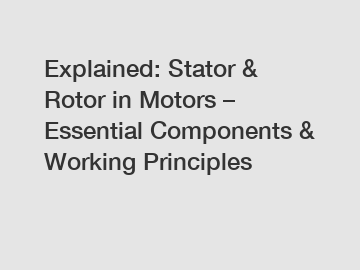Explained: Stator & Rotor in Motors – Essential Components & Working Principles
Motors are ubiquitous devices that power various machines, ranging from household appliances to industrial machinery. While we may not often ponder over their intricate workings, it is fascinating to delve into the heart of a motor and uncover the fundamentals that make it tick. In this article, we will unravel the essential components of motors, specifically focusing on the stator and rotor, shedding light on their working principles and their indispensable role in motor operations.
Understanding Motor Basics:
Before diving into the stator and rotor, let us establish a foundational understanding of how electric motors operate. At their core, motors convert electrical energy into mechanical energy by utilizing the principles of electromagnetism. Powering a motor through an electrical source sets off a chain reaction, leading to rotational motion output.

The Stator - The Immovable Force:
The stator, as its name implies, remains stationary within a motor. It serves as a crucial component that facilitates motor functionality. Composed of laminated iron cores designed for optimal magnetic coupling, the stator acts as a source of electromagnetic fields.
Coils of wire, referred to as windings, are wound around the stator's iron cores. These windings are connected to an electrical power source, typically an alternating current (AC), to generate the magnetic fields essential for motor operation. When energized, the stator's windings produce a rotating magnetic field, allowing the motor to initiate action.
The Rotor - The Moving Force:
While the stator remains stationary, the rotor is the moving force within a motor. It comprises a central shaft and a set of conductive bars, often referred to as squirrel cages, that surround the shaft. These bars can be solid copper or aluminum conductors.
The rotor is designed to interact with the rotating magnetic field generated by the stator. When the stator's magnetic field is initiated, it induces an electromagnetic force on the rotor's conductive bars. This interaction creates a torque, initiating rotational motion in the motor's shaft.
The Significance of Stator and Rotor Synchronization:
To ensure efficient motor operation, synchronization between the stator and rotor is crucial. This synchronization is achieved by carefully designing the number of poles in the stator and rotor. Pole pairs refer to a magnetic north and south pair generated by the stator's windings.
The rotor's conductive bars align with the poles generated by the stator. An equal number of poles in the stator and rotor facilitate synchronization, allowing for optimal torque production and efficient conversion of electrical energy into mechanical energy.
Working Principles - The Motor Journey:
To comprehend the intricate dance between the stator and rotor, let us briefly outline the motor's journey. When an electrical current passes through the stator's windings, a rotating magnetic field is established, propelling the rotor to initiate movement. As the magnetic field rotates, it induces voltages in the rotor's conductive bars, resulting in current flow, the result of electromagnetic induction.
This induced current then interacts with the magnetic field, creating an additional magnetic force that propels the rotor forward. This iterative process continues, generating a steady rotational motion within the motor.
Conclusion:
The stator and rotor, two essential components in electric motors, are the pillars upon which motor functionality rests. While the stator generates the rotating magnetic field, the rotor interacts with this field, initiating motion. Synchronization between these components ensures optimal motor efficiency and reliable output.
Understanding the intricacies of stator and rotor interactions helps in appreciating the intricate yet seamless operations of electric motors. Whether in household appliances, industrial machinery, or electric vehicles, motors continue to revolutionize our world. With a grasp of these fundamental components and their working principles, we gain a deeper appreciation for the phenomenal machines that power our lives.
If you want to learn more, please visit our website stator and rotor core, stator and rotor manufacturer, lamination welding.


